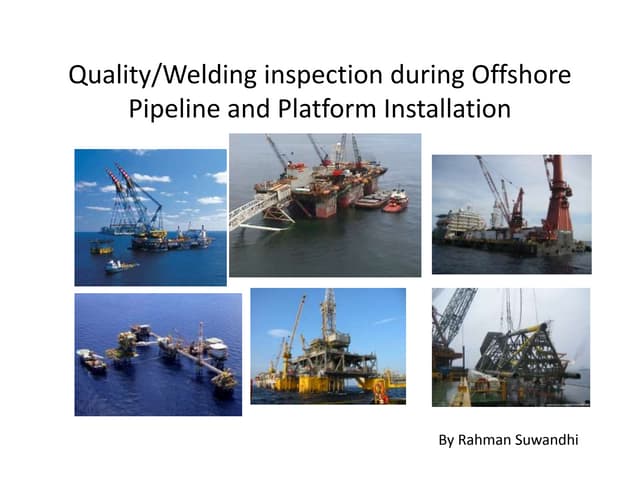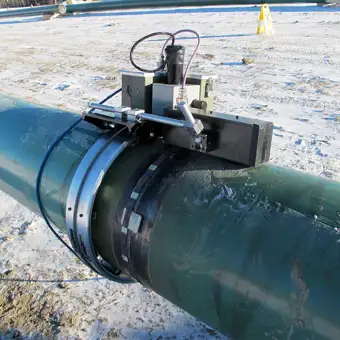Recognizing the Principles of Pipeline Welding Assessment: Important Elements for Assessing Weld Quality and Stopping Failures
In the world of pipe welding examination, the stakes are without a doubt high, requiring a complete understanding of essential concepts to guarantee weld quality and alleviate failure dangers. Different critical elements come right into play, including the selection of suitable materials, the application of advanced inspection strategies, and the recognition of widespread welding problems.
Relevance of Weld Top Quality
The honesty of a pipe is essentially dependent on the quality of its welds, making weld quality a crucial variable in guaranteeing risk-free and efficient operation. A pipe weld acts as a joint factor where products are joined, and any type of deficiencies in this field can result in considerable architectural weak points. Poor weld quality can lead to leakages, ruptures, and tragic failings, posturing major security threats and environmental risks.
Several elements add to the top quality of a weld, consisting of the option of welding procedure, the skills of the welder, and the conditions under which the welding is carried out - Pipeline Welding Inspection. Insufficient preparation, incorrect warmth input, and contamination can endanger weld stability, bring about issues such as porosity, incomplete blend, or splits. For that reason, rigorous quality assurance actions should be executed throughout the welding procedure to reduce these risks
Additionally, the long-term efficiency of a pipeline is greatly influenced by the sturdiness of its welds. Top quality welds not just enhance the total stamina of the pipe but also expand its life span, minimizing the need for pricey fixings and downtime. For this reason, guaranteeing exceptional weld high quality is paramount in pipe style and maintenance techniques.
Key Inspection Techniques
Guaranteeing weld quality necessitates the application of efficient assessment techniques to recognize possible flaws before they lead to failings. Pipeline Welding Inspection. Among one of the most widely utilized approaches are visual assessment, radiographic screening (RT), ultrasonic testing (UT), and magnetic fragment testing (MT) Each method is and serves a distinctive purpose chosen based on the particular requirements of the pipeline job
Aesthetic examination is the very first line of protection, enabling examiners to analyze surface conditions, positioning, and overall handiwork. Radiographic testing supplies a comprehensive sight of interior weld stability by using X-rays or gamma rays to find subsurface problems.
Ultrasonic screening utilizes high-frequency audio waves to review the thickness and stability of welds, making it perfect for finding inner gaps. Magnetic bit screening is a reliable approach for identifying surface area and near-surface flaws on ferromagnetic products by using magnetic areas and great ferrous fragments. By using these key assessment strategies, pipe welding examiners can make sure the best standards are preserved, ultimately resulting in much safer and a lot more reliable pipe systems.
Common Welding Flaws
Amongst the most prevalent defects are porosity, which takes place when gas entraps in the weld steel, developing voids that compromise the joint. Another considerable concern is lack of blend, where the weld metal does not appropriately bond with the base material, endangering the joint's toughness.

Cracks are likewise a critical worry, showing up in different types such as hot splits, cold splits, and root splits. Each type postures unique obstacles and requires certain evaluation techniques for detection. Undercut is an additional problem that can reduce the weld's cross-sectional area, bring about stress and anxiety concentration points, while slag inclusion happens when non-metallic material ends up being caught in the weld pool, adversely affecting the mechanical residential properties of the weld.
Furthermore, incorrect grain shape can lead to irregular tension circulation. Recognizing these common flaws is important for welders and assessors alike, as early detection and adjustment are vital to ensuring the longevity and integrity of pipeline systems.

Materials and Their Impact
Selecting the proper materials for her comment is here pipeline welding dramatically affects the total performance and reliability of the bonded joints. The option of base metals, filler materials, and finishes plays a vital duty in figuring out the stamina, deterioration resistance, and durability of the welds. As an example, carbon steel is commonly made use of for its equilibrium of stamina and expense, however it might be vulnerable to rust in specific atmospheres, requiring the usage of safety coverings or corrosion-resistant alloys.
Furthermore, dissimilar steel welding requires mindful consideration of thermal development buildings and potential galvanic corrosion. The compatibility of materials can substantially impact the microstructure of the weld, bring about variants in mechanical buildings. For instance, stainless-steel uses superb deterioration resistance yet may need particular filler products to make certain a sound weld joint.
Furthermore, the influence of temperature and environmental conditions on product selection can not be underestimated. High-strength steels may lose ductility at raised temperature levels, while low-temperature applications might call for products with boosted strength. Ultimately, recognizing the implications of material options is vital for accomplishing optimal weld quality and preventing failings in pipeline systems.

Governing Specifications and Compliance
Regulative standards and conformity play a critical duty in pipe welding, establishing the framework within which safe and efficient methods are maintained. These requirements are established by various organizations, including the American Society of Mechanical Engineers (ASME), the American Welding Culture (AWS), and the Pipe and Hazardous Materials Safety Administration (PHMSA) Following these guidelines ensures that welding click reference procedures fulfill the required top quality and security standards.
Conformity with regulative criteria is crucial not only for making sure the stability of the welds however also for securing the setting and public safety and security. Assessors are tasked with confirming that welding procedures follow these criteria through rigorous evaluations of both the procedures and the final welds. This entails evaluating welder credentials, welding procedures, and the products utilized.
Failing to abide by recognized guidelines can result in significant consequences, consisting of costly repair services, legal responsibilities, and disastrous failings. For that reason, companies need to incorporate compliance right into their operational techniques, fostering a society of safety and top quality. Normal training and audits are crucial elements in keeping adherence to these regulatory standards, guaranteeing Continue that all workers are well-informed and equipped to copyright the highest degree of pipeline welding high quality.
Final Thought
In final thought, a detailed understanding of pipeline welding inspection is important for making sure weld high quality and stopping failures. By utilizing key evaluation techniques and identifying usual welding problems, examiners can properly examine the integrity of welds.
In the realm of pipe welding examination, the risks are undoubtedly high, necessitating a complete understanding of basic concepts to make certain weld top quality and alleviate failure dangers (Pipeline Welding Inspection).The integrity of a pipe is basically reliant on the top quality of its welds, making weld top quality an important element in making sure efficient and secure procedure.Several elements contribute to the quality of a weld, consisting of the option of welding procedure, the abilities of the welder, and the problems under which the welding is performed. Undercut is an additional problem that can decrease the weld's cross-sectional location, leading to stress and anxiety focus factors, while slag incorporation happens when non-metallic material becomes entraped in the weld swimming pool, detrimentally influencing the mechanical homes of the weld
In final thought, an extensive understanding of pipeline welding evaluation is crucial for ensuring weld quality and preventing failures.